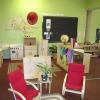- Distinguish between spaces for group experiences, privacy, storage, and display.
- Identify characteristics of a well-designed indoor learning environment.
- Learn ways to arrange an indoor learning environment to promote infant and toddler growth and development.
- Describe how to organize materials for independence, easy use, and learning.
Learn
Know
Infant and toddler caregivers make many decisions each day: which books to read, what questions to ask families, which experiences to offer, how to arrange materials, etc. In many instances, these decisions are the result of careful advanced consideration, in addition to a personal understanding of how an infant and toddler learning environment should be, feel, and look.
Infants and toddlers, like most of us, are drawn to inviting and engaging environments. Thinking about the ways to create a safe, flexible, and playful indoor learning environment requires planning and exploring ideas from multiple perspectives.
Arranging the Indoor Learning Environment
The space and furnishings should come together to create an indoor learning environment that is tailored to meet the needs of developing infants and toddlers. They need close supervision, positive guidance, and stimulating experiences during this period of rapid growth.
When considering the physical space of play areas, it is important to create a space that is not too open or too crowded. Young infants need areas with enough room to practice their growing abilities and movements, such as rolling and crawling. Mobile infants and toddlers need space as they explore and learn to crawl, walk, dance, jump, and build. Space is important for both active and quiet play. Well-designed areas provide both physical boundaries (such as shelves or rugs) and visual cues (such as multiples of the same toy) that support individual and peer play. Space is very important and can enhance or hinder a child’s learning. Too much or too little personal space may make a child feel uncomfortable and could encourage unwanted behaviors (Kaiser, B. & Rasminsky, J., 2020). Caregivers will need space for infant and toddler caregiving routines: greetings, departures, eating and feeding, sleeping, diapering, and toileting. Separate sleeping areas for young infants are recommended so the children can keep their individual schedules while still being monitored. The diapering and toileting area should contain changing tables, sinks, and storage for supplies. These caregiving spaces can provide opportunities for learning. For instance, a mirror placed near a changing table can provide visual stimulation and distraction for a child during diapering. It also provides an additional element of interaction between the child and caregiver. When planning all areas, caregivers must use preventive measures to ensure safe and healthy learning. See the Safe Environments and Healthy Environments courses for further information.
When designing spaces for infants and toddlers, it is also important to consider logistics, aesthetics, organization, and the needs of all children in the space.
Designing for Logistics
There are several things to keep in mind as you design or redesign your learning space. We will distinguish between spaces for group experiences, privacy, places for adults, and storage and display, all of which are critical for a successful indoor learning space.
Places for Group Experiences
Although infants and toddlers learn primarily through exploration and interactions with caregivers, spending time in groups is an excellent way to begin to build an understanding of learning communities. For instance, a brief (5 minute or less) daily group time can encourage infants and toddlers to share their ideas and notice the ideas of others (e.g., a caregiver notices an infant kicking and encourages everyone to kick their feet together, or a toddler says “ice cream” and the caregiver suggests that everyone pretend to eat ice cream together). Caregivers can also lead infants and toddlers in songs with corresponding motions that can help develop motor skills and awareness of the sounds and patterns of language (Lang et al., 2010). Choose a space where the children can comfortably learn together.
Places for Privacy
Infants and toddlers are still developing the ability to regulate their emotions and calm themselves. It is important to provide a calming space for children to take a break from the group. You can help infants and toddlers meet this need by offering spaces that are limited to one or two children and created so that there is still visibility to ensure safety.
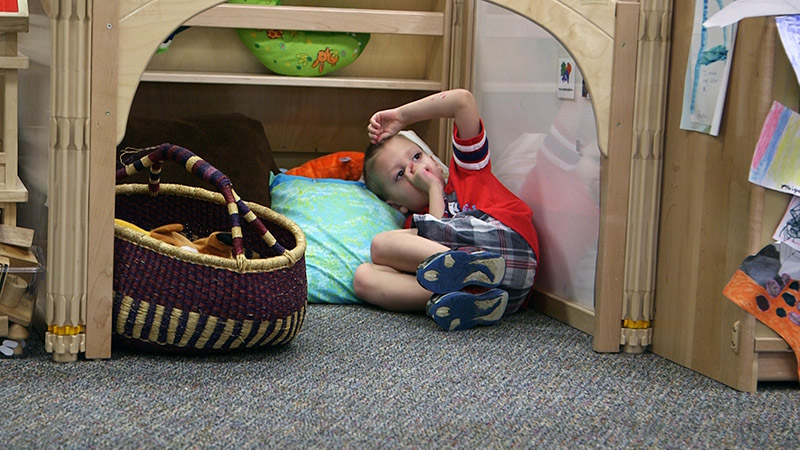
Places and Ways to Support Adults
Although the majority of your room should be designed with infants and toddlers in mind, as discussed in the introductory lesson, caregivers and children’s families are also an integral part of the learning environment. The physical environment should reflect this by having at least some spaces that speak to the adults in the learning environment and make them more comfortable. Remember, children’s own homes are not all child-sized! Here are some ways to make the environment supportive for caregivers, parents, and children:
- Providing a glider or rocker for adults to use during feeding times can help provide a level of comfort and support. This communicates to family members that they are welcome, and it can help nurture relationships between caregivers and children. Adult chairs can serve as a space where family members can read a book to their child during pickup or drop-off times or provide a space for mothers to visit and nurse, and they help build a homelike atmosphere in the room.
- Using carpeted risers not only supports infants’ and toddlers’ use of motor skills but also helps caregivers get up and down during floor play more easily.
- Adding steps to the changing table in the diapering area for older toddlers to walk up can reduce the number of times that caregivers need to lift heavier children, while also giving older toddlers a sense of autonomy.
- Creating a communication or display board provides family members with important information about your room (e.g., the weekly curriculum, special notes from the day, or upcoming events).
Places for Storage and Display
Infant and toddler learning spaces require a lot of materials! Toys, books, and other resources are regularly rotated in and out of active use. It is important to plan for at least three kinds of storage in an infant and toddler learning space: open storage for children to access, closed storage for caregiver materials, and storage for personal belongings (Dodge et al., 2015). It is also important to plan for storing and displaying children’s assessment materials and artwork. Storing and displaying artwork and portfolios sends powerful messages to children about the value of their work and helps you do your job more effectively. The following video discusses these kinds of storage. Think about the ways your environment already addresses the suggestions and reflect on changes that could be made.
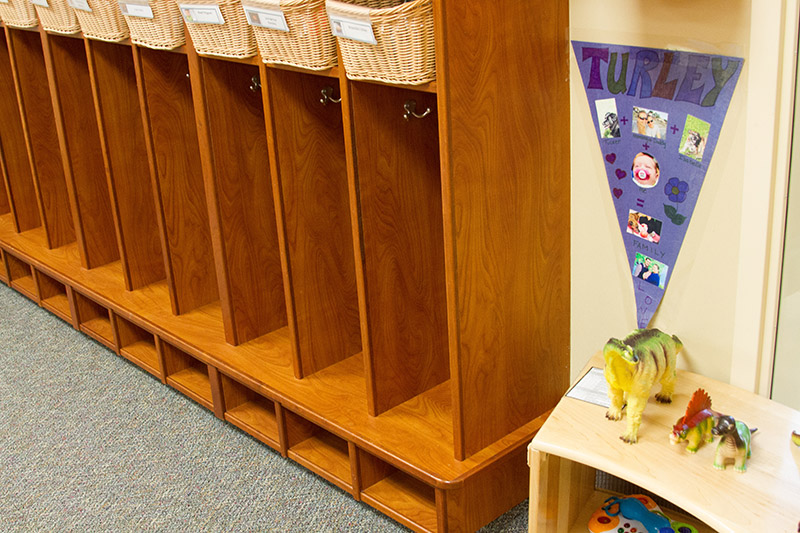
See
There are many ways to design learning spaces. Watch this video to see examples of ways infant-toddler learning spaces have been designed for group experiences, privacy, storage, and display.
Designing Spaces for Learning
Aesthetics
In the introductory lesson, we addressed that high-quality infant and toddler programs send numerous positive messages to children. One of the best ways you can communicate to children that your classroom is “a good place to be” is through the small touches you place throughout the room that express the personality of the group.
Homelike
Children are more likely to feel they can be themselves and have a sense of belonging when their classroom environment feels like home. “The ideal, connected approach is not to simply fill classroom spaces. Rather it is to create an environment that is meaningful to the children,” write the authors of Rethinking the Classroom Landscape: Creating Environments That Connect Young Children, Families, and Communities (Duncan, S., Martin, J. & Kreth, R., 2016, p. 79). There are many ways you can add personal touches to your classroom to create these ideas (we will address this more in Lesson Four). For example, you can include:
- Soft furniture, such as a couch or large armchair
- Nontoxic plants
- Natural or soft lighting, through the use of windows or lamps
- Throw pillows, cushions, blankets
- Other decorative touches, such as area rugs or repurposed furniture
- Family photos of the children and staff
- Inexpensive frames to hang children’s artwork on the walls
- Neutral paint colors
Creating a relaxing homelike environment is critical for children who may spend several hours a day in your classroom. It can be overwhelming to spend eight or twelve hours in spaces with lots of bright lights or bright colors.
Including pictures of the children and their families, in conjunction with personal storage and displaying children’s artwork, is another great way to communicate that the space belongs to the children. When displaying pictures or adding decorative touches, remember to hang or offer many photos or decorative items at children’s eye level to reinforce that they are valued members of the classroom space. Consider taping pictures to the floor, or arranging them on a low shelf, so mobile infants can see them as they move about.
Inviting Engagement: Provocations
Offering items of beauty or wonder in the classroom invites infants’ and toddlers’ exploration and engagement. You can do this by using provocations. A provocation is a picture, experience, or item that provokes thought, interest, questions, or creativity (Edwards, 2002). Provocations can help provoke young children to use, think about, or see materials in new ways. When designing your classroom, it can be useful to think about how you will incorporate provocations. Your inspiration for what provocations to offer will often come from children’s current interests, their emerging developmental skills (e.g., crawling or grasping), or their learning goals. Provocations might include:
- Pictures: Including pictures of interests can help extend exploration of certain concepts and send the message that children’s ideas are valued in your classroom. Use pictures of real items as much as possible. Also, when applicable, offer several different pictures. This allows children to recognize that not all trees look the same, or that some dogs have spots and others do not.
- An event or experience: For example, go on a nature walk outdoors or host a “picnic” in your classroom. You can also take pictures during the event to display later. Using pictures of experiences with which the children engage with one another in the learning environment communicates that this space belongs to the children. It also provides them with concrete documentation to reflect back on the experience.
- Books: Strategically placing books relevant to children’s current interests around the room can change how they engage in the space. For example, offer a book on construction sites next to the blocks, or a book about babies next to dramatic play.
- Physical items of interest: Adding an authentic item as provocation can support what children already know about their world, or invite them to touch, smell, see, or hear something new. This can include items from nature, such as leaves or nuts, or a vase of fresh flowers. Consider asking families to provide items from home, especially ones with cultural relevance like a piece of fabric or a paper lantern. Also, adding things like an old record player or piece of stained glass can elicit new discoveries.
- Simple changes in display: For example, add a child-safe mirror on the floor for children to see themselves as they crawl over, or set up the doll babies in dramatic play with small bowls and spoons, which can invite the older infants and toddlers to “feed” the dolls. For infants and toddlers, changes in display can also include rearranging climbing equipment to offer new challenges or incorporating different textures and colors on the floor.
Consider the placement of your provocations. What are you hoping infants and toddlers will do within each area of your classroom? What concepts are you currently exploring or developmental goals are you working toward, and how might a provocation in certain areas help extend or focus children’s play? Provocations are meant to be a guide or a point of inspiration for how infants and toddlers can engage with certain materials or spaces and are not meant to limit what children are supposed to do in each area or with the materials. Although you may have a clear intention for how the items will be used, the children may have a different plan. Not every provocation will interest every infant or toddler or provoke the kind of play you expect. The beauty in provocations is observing how each child uses it.
Designing for All
When you look to design or redesign your classroom, you need to consider the needs and learning goals of all children. Each time a new infant or toddler enters your room, you should consider what adaptations are needed to best support their engagement and safety in the classroom, as well as the individual’s previous experiences. For children with disabilities, it is important to speak with the child’s family and your trainer, coach, or administrator so you know the child’s particular needs and what supports will help them. As we will discuss in Lesson Four, ensuring that your classroom is welcoming to children from diverse cultural backgrounds is also critical to supporting the success of all children in your room.
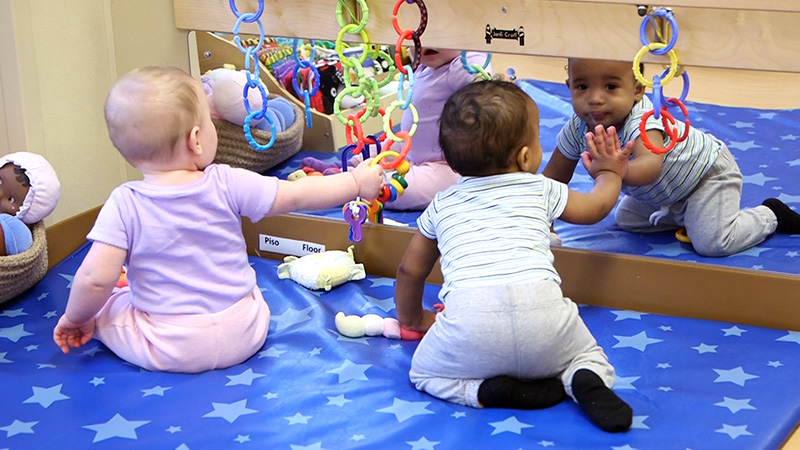
In terms of environmental design, you may need to consider the physical space within learning areas or pathways between areas to ensure that infants or toddlers with physical disabilities can easily move around and participate, or caregivers can comfortably move them throughout spaces and participate with them. See the References & Resources section of this lesson for more information on adapting the learning environment for children with special needs. The next video discusses designing spaces and selecting appropriate materials for all children in your program space. Listen as one teacher reflects on how she adapts the environment and experiences to meet the needs of children in her classroom.
Infants & Toddlers: Cultivating Spaces for All Learners
Organization
Consider how you might feel if a familiar store has been completely rearranged when you walk in to make a quick purchase? In a learning environment, caregivers and children may also feel frustrated when they cannot find what they need or when materials for play are unavailable. As a caregiver, it is your responsibility to ensure materials are easily accessible and well organized. When organizing your materials, you should think about three goals: independence, easy use, and learning.
Organize for Independence
First, as children develop, we want them to learn that they can find and use materials on their own. The best way to accomplish this is to store materials on low, open shelves. This lets children see the materials available, make a choice, and return the item with less adult support. Keep in mind though, that too many choices can be overwhelming. Second, we want children to learn to use signs and symbols in the environment to support their independence. One way we help them do this is by carefully labeling objects or the places the objects belong. The best labels use written words plus pictures or parts of the object (like a puzzle piece on a shelf that contains wooden puzzles). Labeling not only helps children learn to access toys and eventually clean-up independently, it also creates a print-rich environment. As an added benefit, you may find yourself giving fewer directions and reminders. When children can engage independently with materials, you have more time for interacting and expanding learning opportunities.
Organize for Easy Use
It is important to organize learning and play materials so that you and the children in your care can find what is needed. As infants develop into toddlers, this helps them realize, “I can do things on my own.” It also empowers children to try out ideas and use new materials. When organizing for easy use, think about storing similar materials together.
The types of storage you choose, including bins, baskets, and containers, can affect how easily children can access materials and put them away. For example, storing books on a shelving unit that allows children to see the full front covers of books may spark greater interest in reading and make it easier for children to choose books that interests them. Storing simple wooden puzzles on a puzzle rack will also make it easier for children to choose a puzzle and return it to its place when finished playing. Storage bins should be open (without lids) for materials that you want children to access themselves. They should also be made of lightweight material (e.g., plastic vs. metal) and not too large or too heavy, so that children can handle them on their own. Clear plastic bins will allow children to easily see the materials that are inside. Use bins that are large enough to accommodate materials without tipping over. Baskets should be free of material that could poke or scratch children and should not be used to store materials that can fall out through the holes, such as crayons.
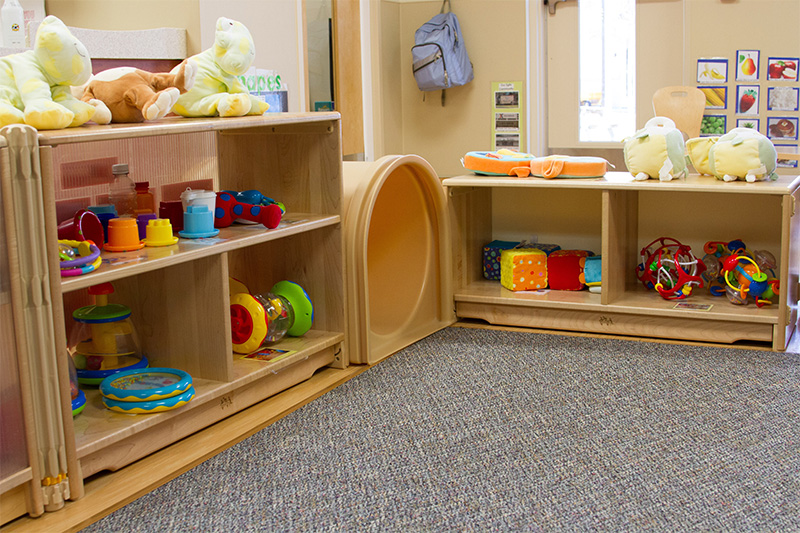
Organize for Learning
It is important to keep the space clean, which involves both adults and children. The steps you take to organize for independence and easy use will also help you keep the space tidy. It will help children to know where materials belong, and they will learn to respect materials and the learning environment.
As discussed previously, the concept of using provocations can help you organize your space to spark or build upon children’s interests. Displays should reflect equity, diversity, knowledge, interests, and experiences of the diverse children in your learning environment. To maintain children’s engagement in play and learning, you will want to rotate materials regularly so children have the chance to use different kinds of materials.
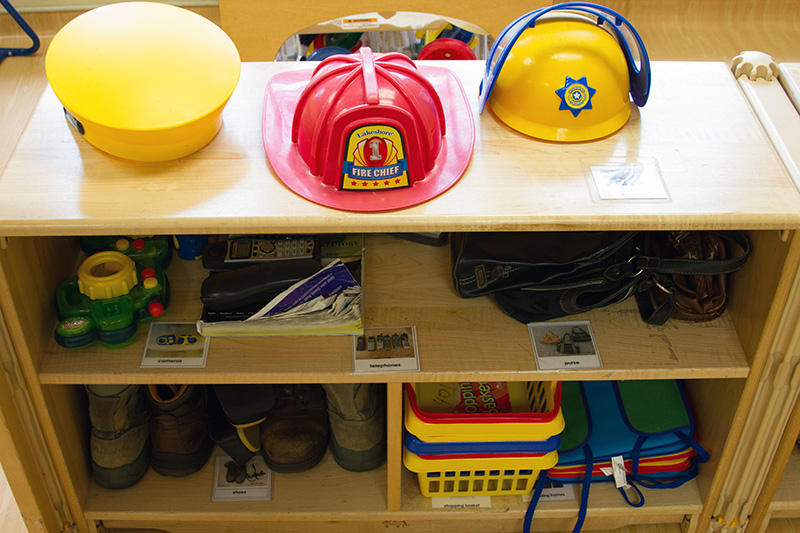
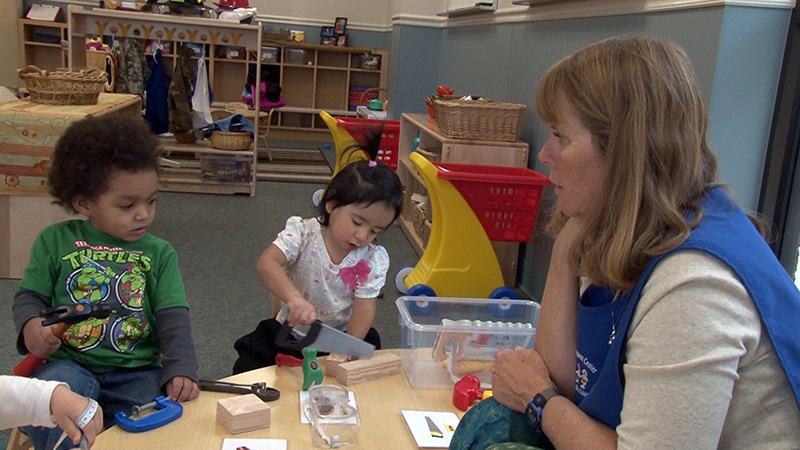
See
It is important to organize your space and materials for independence, easy use, and learning. Let’s look at a few ways infant and toddler caregivers organize their materials to meet these three goals.
Organizing Materials for Play
Do
Learning space arrangement allows you to make your room feel welcoming and like a home while incorporating your knowledge of developmentally appropriate practice. Remember that developmentally appropriate means that the environment you create for children should fit their current stage of development, while still being flexible to allow for differences between children in skills, interests, and characteristics. While designing your indoor learning environment, always consider the following:
- Make Safety A Priority: Be sure to supervise infants and toddlers closely. Check toys and materials for safety every day and remove broken toys or play materials. Make sure that you have secure storage for all items that are unsafe for children. A well-designed learning space will also keep children engaged in appropriate play and help prevent undesirable, unsafe behaviors (e.g., jumping, running).
- Make the Learning Space Feel Like Home: Use some of the suggestions offered in this lesson. Make sure some of your visual displays are at the children’s eye level.
- Plan Ahead: Consider how you will use spaces for group experiences, storage, and display. Then identify the resources you need to make those spaces work. List all the materials you will need in each space based on the activities, storage, and displays that you are planning.
- Organize Materials for Independence, Easy Use, and Learning: Infants and toddlers take cues from the way things are organized to help guide their interactions with the environment.
- Place materials on child-size shelves with space between items so children can easily see each piece. Keep materials in single rows on a shelf if possible.
- Store like materials together on open shelves to help children make connections, and to make clean-up easier.
- Store materials for a specific activity together so children can easily find all the materials needed to complete the activity. (e.g., puzzle pieces in the puzzle board to show a complete puzzle, shape sorters with shape container).
- Use small, clear containers to store like fine-motor pieces, such as rattles, teethers, connecting blocks (with each size and kind having its own container).
- Label shelves and containers with pictures of items for easy clean-up and to support early-literacy skills.
Explore
Using the information you have learned from this lesson, examine your environment while considering the question “If I were an infant or toddler…?” Download and print the Our Indoor Learning Environment Activity to capture your thoughts and ideas. Then share your responses with your trainer, coach or administrator.
Apply
Think about how you could design or redesign your own indoor learning environment. Download and print the Indoor Room Design Activity. Use the grid and labels to help you think about different ways to organize your space. Discuss your ideas with your trainer, coach, or administrator. In addition, download and print the Organizing Materials Checklist. Using the information from this lesson, examine each learning area and play space to determine if materials are organized to support ease of use and learning.
Glossary
Demonstrate
Broderick, J. T, & Hong, S. B. (2020). From children’s interests to children’s thinking: Using a cycle of inquiry to plan curriculum. National Association for the Education of Young Children.
Dodge, D., Rudick, S., Berke, K. (2015). The creative curriculum for infants, toddlers, and twos (3rd ed.). Teaching Strategies, Inc.
Duncan, S., Martin, J. & Kreth, R. (2016). Rethinking the classroom landscape: Creating environments that connect young children, families, and communities. Gryphon House, Inc.
Edwards, C. P. (2002). Three approaches from Europe: Waldorf, Montessori and Reggio Emilia. Early Childhood Research and Practice, 4(1). https://eric.ed.gov/?id=ED464766
Erdman, S. & Colker, L.J. (2020). Trauma and young children: Teaching strategies to support & empower. The National Association for the Education of Young Children.
Extension Alliance for Better Child Care. (2019, August 15). Adapting the child care environment for children with special needs. National Cooperative Extension. https://childcare.extension.org/adapting-the-child-care-environment-for-children-with-special-needs/
Greenman, J. (2005). Caring spaces, learning places: Children’s environments that work. Exchange Press, Inc.
Greenman, J., Stonehouse, A., & Schweikert, G. (2008). Prime times: A handbook for excellence in infant and toddler programs (2nd ed.). Redleaf Press.
Grisham-Brown, J., Hemmeter, M. L., & Pretti-Frontczak, K. (2017). Blended practices for teaching young children in inclusive settings (2nd ed.). Brookes Publishing Co.
Kaiser, B. & Rasminsky, J. (2020). Valuing diversity: Developing a deeper understanding of all young children’s behavior. Teaching Young Children. 13(2). https://www.naeyc.org/resources/pubs/tyc/dec2019/valuing-diversity-developing-understanding-behavior
Nicholson, J., P.S. Driscoll, J. Kurtz, D. Marquez, & L. Wesley. (2020.) Culturally responsive self-care for early childhood educators. Routledge.
Petersen, S. H., & Wittmer, D.S. (2018). Infant and toddler development and the responsive program planning: A relationship-based approach (4th ed.). Pearson.


